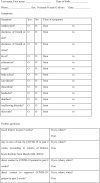Rate and predictive parameters of novel Coronavirus 2019 (Sars-CoV-2) infections in a German General Practice
- PMID: 33594623
- PMCID: PMC7886303
- DOI: 10.1007/s11845-021-02555-w
Rate and predictive parameters of novel Coronavirus 2019 (Sars-CoV-2) infections in a German General Practice
Abstract
Key points: In our clinical cross-sectional study, we identified 107 of 347 patients who were tested positive for antibodies of novel Coronavirus 2019 (SARS-CoV-2). Main symptoms were exhaustion and cough, exposition to other COVID-19-patients appeared frequently.
Background: There is urgent need for information on predictive parameters on immunity and infectivity in Coronavirus disease-2019 (COVID-19) pandemic. Our aim was to investigate distribution of novel Coronavirus 2019 (SARS-CoV-2) infections in a German General Practice and to learn about possible predictive parameters regarding infection and pathways of transmission.
Methods: In our cross-sectional study, we tested 347 patients of our General Practice using 2019-nCoV-2-IgG/IgM antibody test [2019-nCoV2 IgG/IgM Rapid Test Cassette (Ref.: INCP-402/INCP-402B; ACRO, BIOTECH, INC.)]. We asked for 13 specific symptoms and 4 questions to investigate patients' surroundings.
Results: A total of 107 of 347 patients were tested positive for antibodies (Immunoglobulin M-positive and/or Immunoglobulin G-positive). In antibody-positive group, body aches and rhinorrhea were seen more often and there were significantly less asymptomatic patients. Stay in area of risk was significantly more frequent in antibody-positive group as well as contact to infected persons. Distribution of other symptoms was not significantly different between both groups. Most adults or children with SARS-CoV-2 infection presented with mild flu-like symptoms.
Conclusion: A total of 30% of patients had antibodies. It was not possible to identify one solid predictive symptom. Serological testing may be helpful for the diagnosis of suspected patients with negative RT-PCR results and for the identification of asymptomatic infections.
Keywords: Antibodies; COVID-19; Exhaustion; Pandemic; SARS-CoV-2.
© 2021. Royal Academy of Medicine in Ireland.
Conflict of interest statement
The authors declare that patients voluntary contacted our general practice, received reconnaissance, signed consent of participation, and paid 60 Euro for implementation and evaluation of antibody testing as well as explanation of results. There are no further conflicts of interest to declare.
Similar articles
-
The rate of SARS-CoV-2 among asymptomatic non-immunised low-risk parturient women between the two waves.J Obstet Gynaecol. 2022 Aug;42(6):1868-1873. doi: 10.1080/01443615.2022.2049720. Epub 2022 Apr 29. J Obstet Gynaecol. 2022. PMID: 35484953
-
Clinical diagnostic performance evaluation of five immunoassays for antibodies to SARS-CoV-2 diagnosis in a real-life routine care setting.Pan Afr Med J. 2021 May 3;39:3. doi: 10.11604/pamj.2021.39.3.26471. eCollection 2021. Pan Afr Med J. 2021. PMID: 34178231 Free PMC article.
-
[Seroprevalence of anti-SARS-CoV-2 IgG/IgM antibodies in Borgosesia (Piedmont Region, Northern Italy) population: a surveillance strategy in post-lockdown period?].Epidemiol Prev. 2020 Sep-Dec;44(5-6 Suppl 2):200-206. doi: 10.19191/EP20.5-6.S2.119. Epidemiol Prev. 2020. PMID: 33412811 Italian.
-
Seropositivity rate and diagnostic accuracy of serological tests in 2019-nCoV cases: a pooled analysis of individual studies.Eur Rev Med Pharmacol Sci. 2020 Oct;24(19):10208-10218. doi: 10.26355/eurrev_202010_23243. Eur Rev Med Pharmacol Sci. 2020. PMID: 33090430 Review.
-
[SARS-CoV-2 and Microbiological Diagnostic Dynamics in COVID-19 Pandemic].Mikrobiyol Bul. 2020 Jul;54(3):497-509. doi: 10.5578/mb.69839. Mikrobiyol Bul. 2020. PMID: 32755524 Review. Turkish.
Cited by
-
Signs and symptoms to determine if a patient presenting in primary care or hospital outpatient settings has COVID-19.Cochrane Database Syst Rev. 2022 May 20;5(5):CD013665. doi: 10.1002/14651858.CD013665.pub3. Cochrane Database Syst Rev. 2022. PMID: 35593186 Free PMC article.
References
-
- Gorbalenya A, Baker S, Baricet R et al (2020) Severe acute respiratory syndrome-related coronavirus: the species and its viruses – a statement of the Coronavirus Study Group. Preprint at https://www.biorxiv.org/content/10.1101/2020.02.07.937862v1
MeSH terms
Substances
LinkOut - more resources
Full Text Sources
Other Literature Sources
Medical
Miscellaneous


